Elden Ring Piece-by-Piece: The Combat
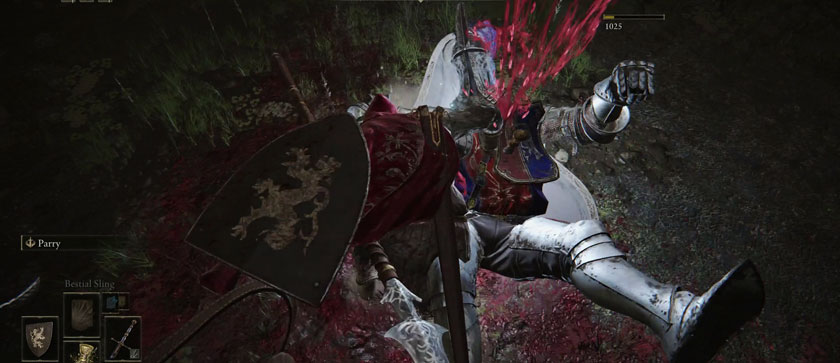
This article is the third in a series exploring the game Elden Ring and its design. You can read the prior entry on the freedom of the open world here.
Unfortunately I cannot be as thorough as I’d like to be regarding Elden Ring’s combat. I’ve barely experimented with magic, whose reputation of being overpowered has been betrayed by my difficulty to construct a satisfying build of the mystical arts early on. I stubbornly insisted on playing a dex-based warrior on my first playthrough, which in hindsight seems to be the least efficient type of character unless you possess magical back-up abilities. In the end, I simply don’t have enough experience to thoroughly discuss the balance of classes, techniques, and spells towards particular playstyles, or which ones the game itself seems to best accommodate.
I must also confess doubt as to whether anyone could experiment with so many builds in such a span of time whilst maintaining objectivity over the game’s quality. Such players are likely already experienced in playing around with From’s systems from prior games, and therefore they are less likely to perceive potential flaws as anything but a feature. When it comes to proper, in-depth analysis of the intricacies of class builds and viable play styles, we’ll likely not see anything with depth or value for another year or two.
Despite my inability to examine Elden Ring’s combat to the most minute detail, I can still look at many of its mechanical additions and what benefit they offer to the game’s combat. In fact, I’ve already learned how difficult it can be to go back to their prior titles, having started a new game in Dark Souls 3 and fought through a few bosses. I would definitely say that, for many players, Elden Ring could be the most enjoyable Soulsborne title to be developed by From Software due to how many dynamic options are now available.
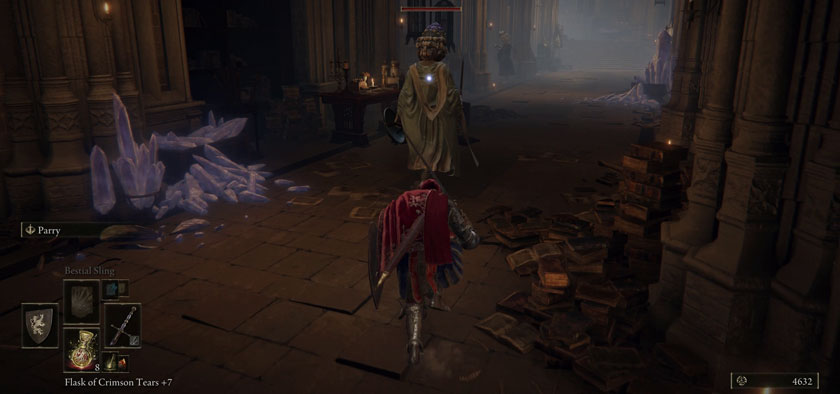
Perhaps the most useful addition is that of the crouch, enabling the player to sneak about undetected even when rubbing up against the back of a sleepy sentry. Though stealth aficionados would be correct in pointing out the simplicity of the system, that simplicity is necessary for it to be such an enticing and effective option for the player. Foes in Elden Ring have three separate awareness levels: complete ignorance to the player’s presence, alert to something suspicious, and complete aggro. Again, it’s not overly complicated, and if the player manages to flee far enough or hide out of sight long enough, then all enemies will go right back to their patrols or places of rest, ignorant of the player’s presence. They don’t remain alert, they don’t respond to friends that weren’t quite so dead just a moment ago, and if the player were to alert them again, they’d behave no differently from before.
This is not a “new” mechanic so much as a much needed expansion upon the prior games’ use of enemy A.I. and aggro. The player could always slowly creep up behind a relaxed sentry, but there was always a chance the target would take notice before the player had an opportunity to stab them in the back. This was especially true for more powerful foes. Now, no matter how slowly or swiftly the player is sneaking, their presence goes unnoticed so long as they remain crouched.
Is it simple and exploitative? Certainly, but the point isn’t how in-depth the stealth mechanics are. Stealth isn’t presented as a binary A or B choice throughout the game’s environments. It is always an option, and should you get caught you aren’t locked out from further sneaking around. You can try to take out each foe one-by-one or you can slip on through as if you were never there. In fact, there are many zones in which sneaking past a super powerful beast or iron clad warrior is the preferable option.
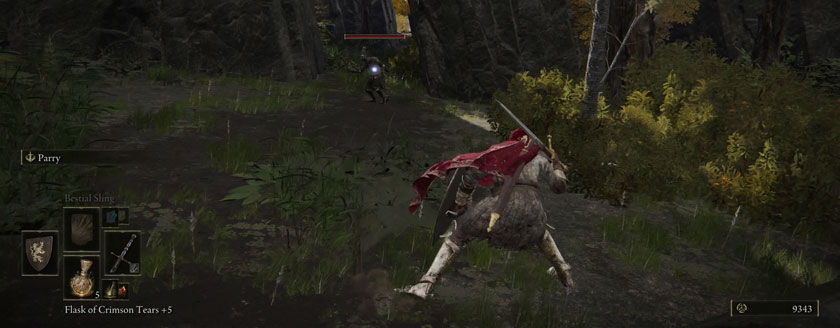
This little guy is going to investigate the spot where I just back-stabbed his buddy. The action took place far enough away that he was alerted, but not set to full combat mode. This made it easier to sneak around his cone of vision for an easy kill.
Which is why I think it is actually implemented greatly in Elden Ring. Oftentimes I’ll simply sneak up to an enemy in order to take out a decent chunk of their health with a back attack, and other times I’ll seek to clear out an entire zone or room by silently assassinating everyone present. It’s not really done with the mentality that certain sections are designed specifically to be snuck through. Instead, it’s simply another option available, and players are just as likely to be baited into an ambush by a seemingly oblivious patrolman should they get too carried away. Regardless, it is a new tool that fits into the long-time philosophy of From Software’s difficult games: cautious behavior and clever tactics can turn a seemingly impossible encounter or location into an easy yet bloody walk through the park.
Throwing knives, loosing arrows, and utilizing other small traps or tricks to lure foolish foes from the greater mob is a similar long-term tactic that experienced Souls players have long relied upon. Whether they’ve been used to bait out the bait of an ambush or reduce the size of the crowd in the next room, the Soulsborne titles have provided a great host of items with which to turn uneven odds into a series of one-on-one skirmishes.
Such tactics are far more prevalent in Elden Ring through the ability to craft one’s own equipment. While some might not consider it a combat mechanic specifically, the freedom to collect and combine ingredients into an assortment of sidearms, explosives, and medicines allows for a greater freedom to experiment. You only have seven fire pots with which to throw? Good thing you can instantly craft seven more, so long as you have the materials to do so. Flaming arrows? Poison bone darts? Sleeping potions or dragonwound grease? All available to be crafted anytime, anywhere.
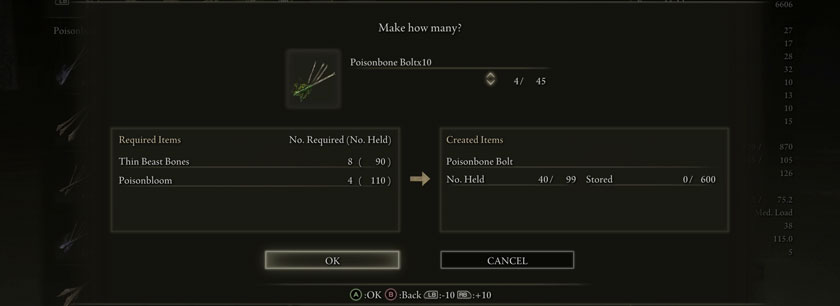
I could craft 450 poison bolts if I wanted, and I don’t even really seek these ingredients out. Such a wealth of crafting riches with which I can experiment and test enemy susceptibility with!
The finite quantity of such tools and the cost to replenish from a merchant actively discouraged me to experiment so often in Bloodborne, Dark Souls, and Dark Souls 3. There was a considerable cost to each item used, and if used at an inopportune time it meant being unable to utilize that weapon in a more opportune moment. During any such cost-benefit analysis, most players would rather choose to save their rare commodity rather than risk wasting it. Elden Ring eliminates that calculation by allowing the player to create such materials themselves. Be it plucked from the bushes of the overworld, carved from the walls of a cavern or mine, picked from a catacomb, or gut from the wildlife of the lands, there’s a whole assortment of useful items scattered throughout the Lands Between. Every cookbook discovered is a prize, an expansion to one’s arsenal and therefore a greater assortment of tactical possibilities.
In other games, crafting materials are often a sort of gameplay crutch, an effort to insert more dopamine hits into a gameplay loop by giving the players small little collectibles to chase that can then be reconstituted into a useful tool. In Elden Ring, however, it plays into the illusion of a living world filled with flora and fauna, all of which can be harvested and utilized for your own combat purposes. There’s less need to purchase these items when you can just craft them, and since it makes sense for the materials to “respawn” throughout the world, your resources need not be finite. It is a minor addition, but the impact made upon how a player engages with their enemy increases dramatically.
There are two more additions to Elden Ring’s primary combat repertoire, and those are the jump and the guard counter. Leaping into the air and striking down hard upon one’s foe is an additional “poise-breaking” tool for every character build, though it is naturally most useful for strength-based weapons and classes. Attacks that break poise can not only interrupt an opponent’s action, they steadily stun them, causing them to drop down to their knees or belly and expose themselves to a critical strike. Most lighter, dex-based weapons have less poise-breaking capability, but jump attacks will increase the ability to stun or interrupt a foe.
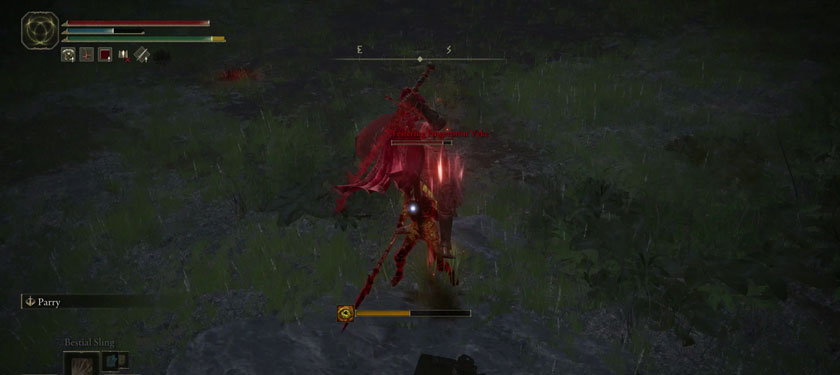
The jump can additionally be used as an evasive maneuver should the player learn and adapt to each enemy’s attacks. Earth-shattering strikes can be avoided by timing one’s jump correctly, allowing the player an opportunity to close with a heavy strike rather than trying to dodge or flee away in time, often resulting in being knocked over or hurt by the wider area of effect. Sweeping attacks can also be avoided with a leap, though it can be troublesome determining which of these is able to be leaped over and which might catch you in mid-air. Nonetheless, just as it is an additional offensive option, it also makes for a defensive maneuver.
Guard counters, meanwhile, are a more “newbie friendly” alternative to the shield parry. Throughout the Souls series players have been able to deflect an incoming attack with precise timing, catching their foe off guard and leaving them vulnerable to disembowelment. It can be difficult to pull off, however, and requires the player to study and often fail at attempting a parry before learning the correct moment to deflect. The guard counter, on the other hand, simply requires the player to use a strong attack after an opponent’s blow bounces off of their shield. It does not guarantee a critical strike, but like the leap attack it increases the odds of stunning the opponent or breaking poise. However, most tricky foes will have not just one attack, but multiple blows with which they’ll come at the player, and the attempted guard counter may leave them vulnerable to interruption if activated too early or too late in the onslaught.
The Soulsborne series has always had a satisfying combat design predicated on moments of caution and moments of aggression. A player should never be a specialist in one or the other, instead trading defense for offense based on their opponent’s attack phase and vulnerability. There have always been smaller tricks to assist the player offensively, such as knowing how susceptible a boss might be to poison or similar status ailments, but otherwise Soulsborne games, at their root, have been about the dance between player and foe. With Elden Ring, these options have greatly been increased through the addition of stealth mechanics, a crafting system with which to expand their arsenal, and the fusion of defense and offense in the jump and guard counter mechanics. None of these changes convolute the game design, but instead offer more ways in which the player can trade off between caution, defense, and aggression.
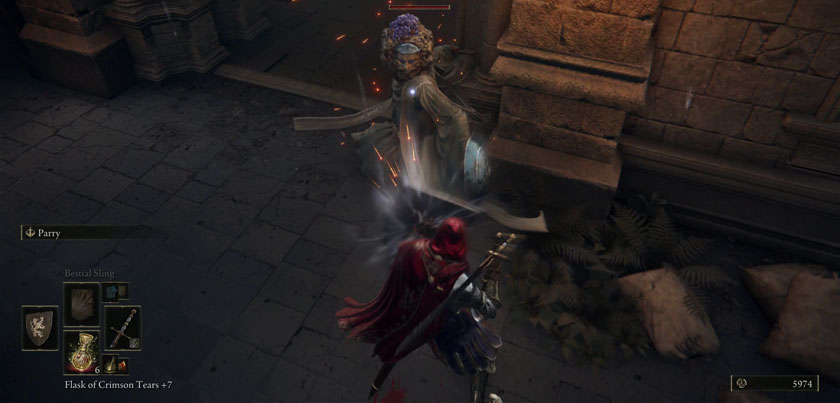
That flash around my character’s shield is joined by a high-pitched, bell-like sound to indicate a successful activation of the guard counter. However, just because you succeeded in activating it doesn’t mean the blow will land or go uninterrupted.
As many have said about Nintendo games, it’s simple to learn but takes time to properly master. Anyone should be able to pick up a controller and, after some experimentation, be capable of using any of these new changes intuitively. The real trick is whether the player can learn to judge the appropriate time to utilize these mechanics on a macro or micro level: across an entire room or dungeon or within a duel, respectively. For this reason it is difficult to go back to some of the prior Soulsborne games, as these additions feel so natural and valuable that there is a distinct something missing once they’re gone. It’s not that these mechanics are “better” than what is available in the old games, and those titles still retain their old dance of dueling blades. It’s more a matter of building up rather than replacing, and they all feel like such a natural evolution that those prior titles, fun as they may remain, now feel incomplete or too restrained.
Now, while these are the bulk of the changes that have evolved the core of From Software’s combat, they aren’t the only additions to have been made. One of the most advertised new features is Torrent and the ability to combat on horseback, which has seen a lot of mixed response from players. Initial impressions are often negative, either regarding Torrent’s imprecise movements and limited evasion or the simplicity of combat options. Torrent has no proper evasive maneuver like the player’s block, parry, or dodge roll. You can try and increase Torrent’s speed, but it provides no temporary invincibility and is not fast enough to escape certain blows from larger creatures or bosses. While there are some attacks that can be avoided with a well timed double-jump, they are less frequent than those capable of outpacing Torrent’s stride.
This is likely due to Torrent being designed for a more hit-and-run style of combat. Charge in, unleash a few blows, then hastily make your temporary retreat. Pick away at the outer edges of huddled enemies, circling them and chipping away at their health rather than trying to eliminate them one-at-a-time with multi-hit combinations. Always be on the move. These are the primary principles of mounted combat, and it makes sense in regards to how most cavalry might have fought throughout history. Under the right circumstances, charging forward on horseback and taking out a few wolves, demi-humans, or soldiers with a single swing can be an invigorating, empowering experience. Under others, however, Torrent can feel like more of a burden than an advantage.
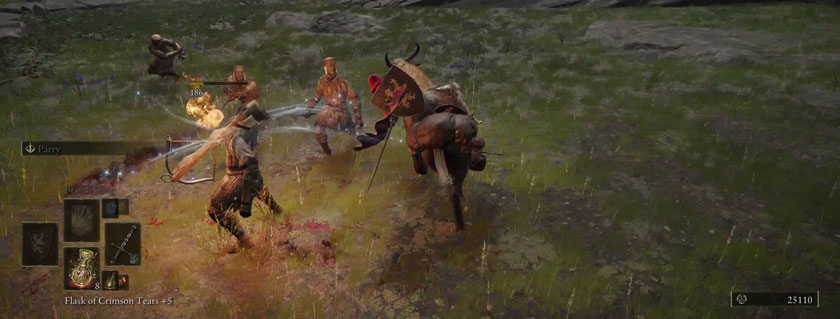
Most of all, mounted combat is overly simple. Whereas typical combat is easy to learn but takes time to master, there is little to master on horseback. There’s just not enough depth here.
This doesn’t mean that a fight cannot be entertaining while riding upon Torrent. As stated, there’s something empowering about dragging your blade close to the ground, cutting into a group of frail soldiers before concluding with a mighty swing into the knight leading the patrol. Such is a reward for considering your approach carefully and then making your escape just as swiftly. Careless players might easily find themselves caught in the middle of a crowd, struck down from all sides until Torrent despawns. This, I believe, is the game responding to the player now caught in a bad situation, removing their mount from the equation in order to allow for some defensive mobility on foot. Unfortunately, such hordes can be numerous and aggressive enough that the player dies, regardless. Hopefully a lesson is learned not to charge into a group of well-armed opponents.
Once such harsh lessons are learned, however, there’s nothing more to experiment with. Once you know to stick to the outer rim of a group, taking swift swipes before coming around for a second pass, then all such encounters will involve this repeated action ad nauseum. As for larger overworld foes, as soon as the player learns the attack patterns of a dragon or a tree sentinel, for example, they know the secret to defeating that foe. Each attack has a pattern, the beasts have body language indicating which attack is coming next, and so long as the player has learned how to dodge said attacks, they can easily avoid getting hurt while striking out at a foe’s legs. It could still be enjoyable enough for many players, as the slightest mistake could result in deadly consequences for the player, but each fight with such overworld beasts becomes a rehearsal for the next.
I do believe these sorts of challenges were a necessity for players, breaking up the game’s action and formula to provide something somewhat different from what they’re doing in caverns and catacombs and fortresses. It is part of what makes the overworld as enjoyable as it is. However, these encounters all become less memorable and gradually blur together. The mounted combat doesn’t really build upon the Soulsborne mechanics like the previously discussed iterations.
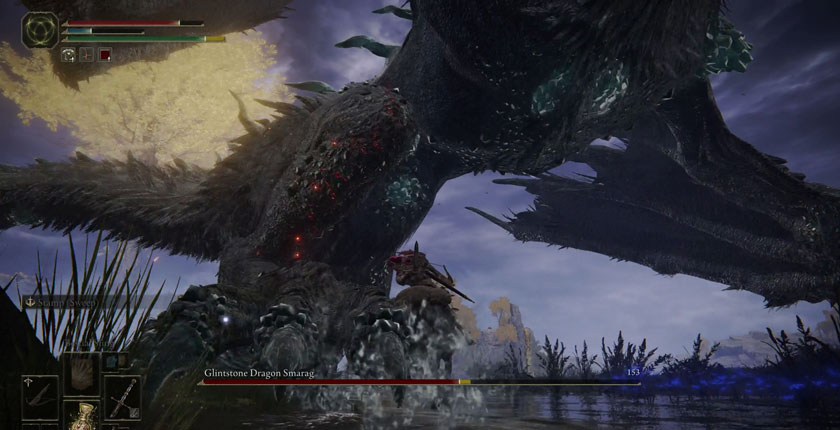
Melee fighters, get used to this view. You’ll be seeing it a lot.
This isn’t to say it is a bad addition. On the contrary, I find that charging into battle on Torrent far more enjoyable than in most games with mounted combat. I’ve also never grown tired of facing off against dragons. At the same time, I can honestly say that I no longer fear dragons in Elden Ring.
The final combat mechanic I’d like to discuss is perhaps its most contentious: spirit ashes. These incorporeally corporeal compatriots are capable of assisting in combat in a fashion summons never could. While all prior Soulsborne titles allow you to summon assistants into a boss arena, be they real players or NPC contributors, it came with the added cost of increasing that boss’ health. Summoned players are also given debuffs, such as reduced health. Spirit ashes, on the other hand, do not increase the health of a boss once summoned, and they can be made quite powerful depending on how much you have upgraded them.
I confess to utilizing the spirit ashes, and I also admit their use is, in some ways, overstated. They aren’t the most clever bunch, taking more hits than they evade and often wading right into hazardous environments such as magma. They also don’t deal much damage, requiring the player to do most of the heavy lifting.
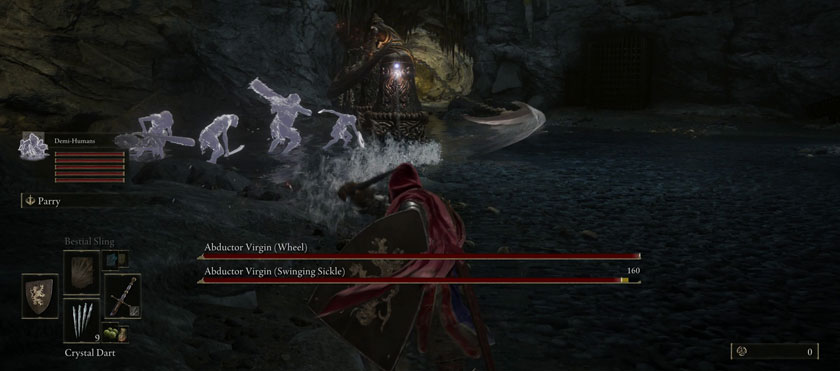
Yet it’s far easier to deal damage when the boss’ back has been turned away from you, exposing them to heavy strikes, leap attacks, and potential backstabs. There’s no real need to learn a boss’ patterns when you have a spirit ash or group of spirit ashes there to draw the enemy’s attention. Just be sure to back away after getting your licks in, as the boss will refocus their attention on you.
I have mixed feelings about the spirit ashes. After all, I use them, and there are some bosses that it feels were designed with the belief the player would be utilizing them. Additionally, it felt rare for my spirit ashes to survive the entirety of many of the game’s battles even when maxed in level. It was at such moments that I had to learn the enemy patterns regardless, or at least figure out when to best summon assistance to ensure survival of the latter stages of the fight.
Part of me feels that the spirit ashes are a detriment to the player. If the player fails to learn patience and caution during boss fights, then the moments those spirit ashes are unavailable will only be more difficult to progress through. At the same time, I’ve watched enough streamers of varying skill levels to know that the spirit ashes cannot save a player from their own inadequacy. It simply lowers the bar necessary to achieve victory.
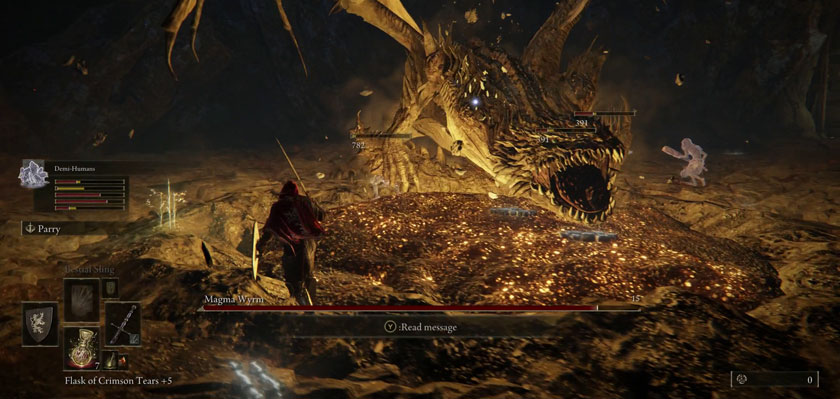
As you can see, the contribution of the spirit ashes were negligible in this fight… and this is before they took a magma bath.
As such, I can only ascertain that the benefit or detriment of spirit ashes is purely up to the player, and as the player is free to use them or lose them, there is no concrete judgment which can be made. The game is still difficult even with spirit ashes, and for some, it is only able to be completed due to the inclusion of spirit ashes. Perhaps From Software would have designed some of the bosses differently if the spirit ashes weren’t there as a crutch?
That, perhaps, is a topic to delve deeper into next time. For now, I would just like to conclude this discussion on Elden Ring’s combat with the observation that so much has been iterated upon and added that the assessment of the game being “open-world Dark Souls” is being disingenuous. I’d be remiss if I didn’t mention that From had technically added stealth and jumping to Sekiro: Shadows Die Twice, though that game had been in development alongside Elden Ring. Nevertheless, Sekiro itself has a very different sort of combat than Elden Ring, and while fighting as a Tarnished bears similarities to fighting as a Chosen Undead or Ashen One, it also differs more or as greatly as fighting as a Hunter in Bloodborne.
At its core, I would argue that Elden Ring has better combat than its predecessors. However, what mechanics are available to the player are not the whole story. Next week we’ll discuss the game’s monsters and the dungeons that house them.


